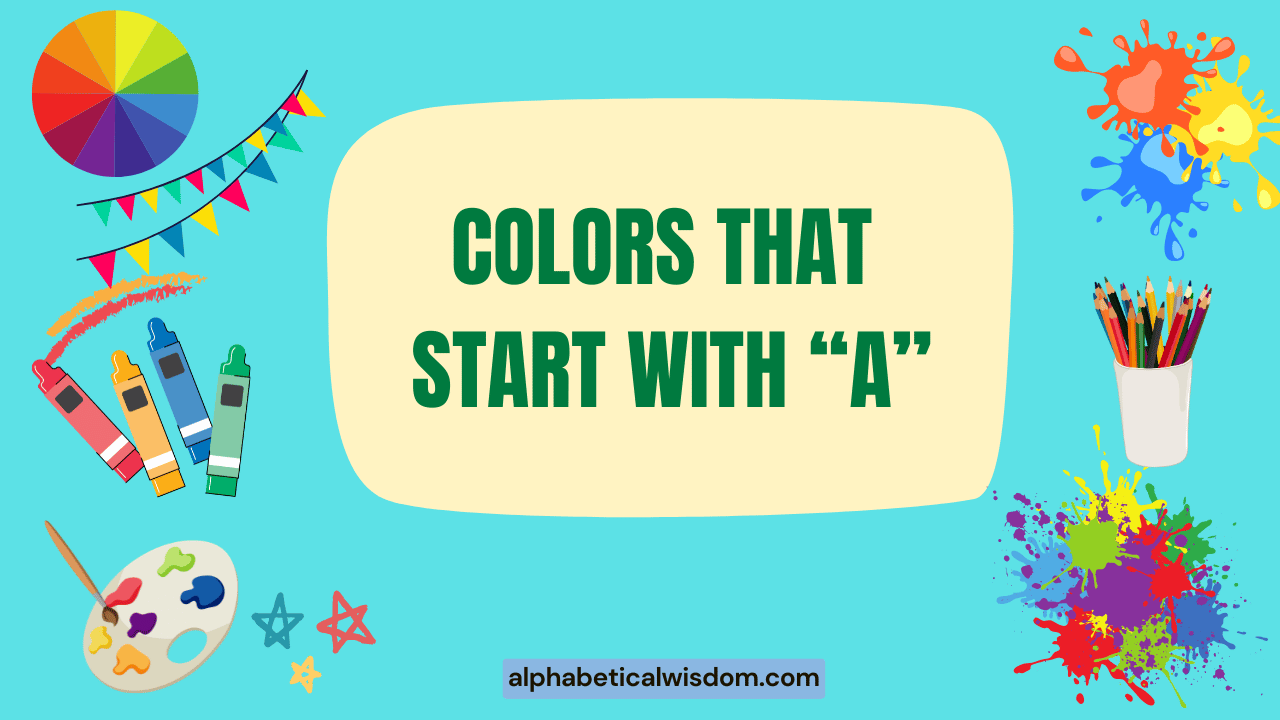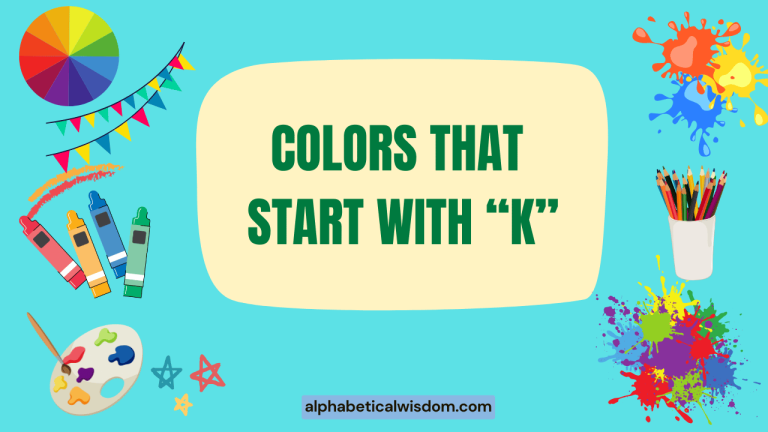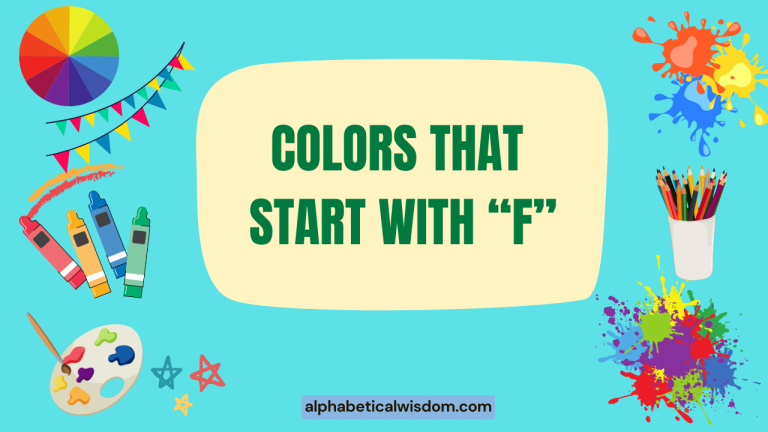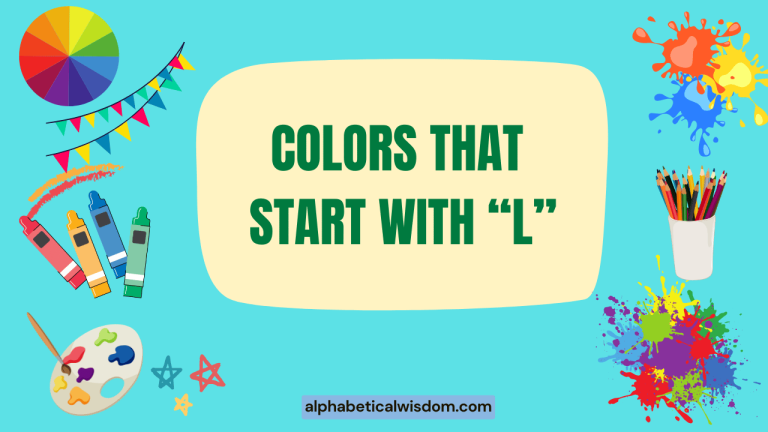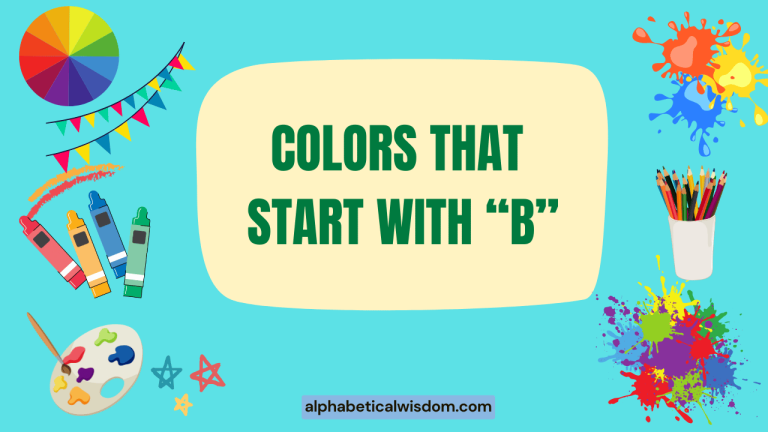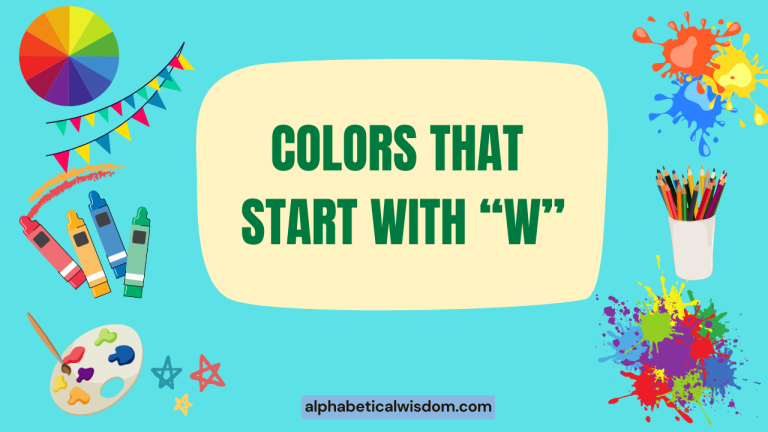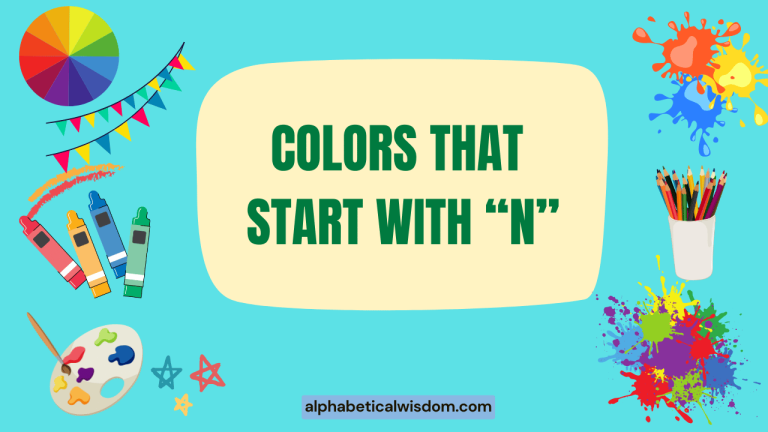Colors That Start With A: A Comprehensive English Guide
Understanding the nuances of color vocabulary is essential for effective communication in English. While the number of colors starting with ‘A’ may seem limited, exploring them enhances both descriptive writing and everyday conversations.
This article serves as a complete guide to colors beginning with ‘A,’ covering their definitions, usage, examples, and common mistakes. Whether you are an English language learner, a writer seeking precise language, or simply curious about expanding your color vocabulary, this guide provides valuable insights and practical exercises to master this specific color subset.
Table of Contents
- Introduction
- Definition of Colors Starting with ‘A’
- Structural Breakdown: Color Terminology
- Types and Categories of ‘A’ Colors
- Examples of Colors in Sentences
- Usage Rules for Color Adjectives
- Common Mistakes When Using Color Words
- Practice Exercises
- Advanced Topics: Color Psychology and Symbolism
- Frequently Asked Questions
- Conclusion
Definition of Colors Starting with ‘A’
Colors starting with the letter ‘A’ encompass a diverse range of hues, each with its unique characteristics and associations. These colors, like all colors, function primarily as adjectives, modifying nouns to provide descriptive detail.
They can evoke specific emotions, set a particular mood, or simply provide information about the appearance of an object or scene. Understanding the subtle differences between these colors is crucial for precise and evocative language use.
In the English language, colors are typically used as adjectives, placed before the noun they modify. For example, “an amber sunset” or “aqua waters.” They can also be used after linking verbs such as “is,” “are,” “was,” and “were,” as in “The sky is azure.” The context in which a color is used often determines its impact and interpretation.
A carefully chosen color can significantly enhance the clarity and richness of descriptive writing and speech.
Structural Breakdown: Color Terminology
The structure of color terminology in English is relatively straightforward. Colors generally function as adjectives, and their placement in a sentence follows standard adjective rules.
They typically precede the noun they describe but can follow a linking verb. Understanding this basic structure is essential for using color words correctly and effectively.
Color adjectives can also be modified by adverbs to indicate shades or intensity. For instance, “light aqua,” “dark amber,” or “bright azure.” These adverbs add further nuance and precision to color descriptions.
Additionally, colors can be combined to create compound adjectives, such as “aqua-green” or “amber-brown,” further expanding the descriptive possibilities.
Types and Categories of ‘A’ Colors
The colors starting with ‘A’ can be categorized based on their specific hues and origins. Each color has its own unique characteristics and associations, making it suitable for different contexts and purposes.
Here’s a breakdown of some common ‘A’ colors:
Amber
Amber is a warm, golden-yellow color, often associated with the fossilized tree resin of the same name. It evokes feelings of warmth, richness, and antiquity.
Amber is frequently used to describe lighting, gemstones, and autumn foliage.
Apricot
Apricot is a soft, pastel orange color, reminiscent of the fruit of the same name. It is often associated with sweetness, freshness, and vitality.
Apricot is commonly used in interior design, fashion, and food descriptions.
Aqua
Aqua is a light, greenish-blue color, often associated with water and the sea. It evokes feelings of calmness, tranquility, and freshness.
Aqua is frequently used in descriptions of oceans, swimming pools, and tropical settings.
Aquamarine
Aquamarine is a pale blue-green color, similar to aqua but slightly more blue. It is named after the gemstone of the same name and is associated with clarity, peace, and serenity.
Aquamarine is often used in jewelry, fashion, and descriptions of pristine waters.
Alabaster
Alabaster is a translucent, milky white color, named after the mineral alabaster. It is associated with purity, smoothness, and elegance.
Alabaster is frequently used in descriptions of sculptures, skin tones, and fine porcelain.
Amaranth
Amaranth is a reddish-purple color, named after the amaranth flower. It is associated with royalty, passion, and creativity.
Amaranth is often used in fashion, design, and descriptions of vibrant landscapes.
Ash Grey
Ash grey is a pale grey color, resembling the color of ash. It is often associated with solemnity, neutrality, and sophistication.
Ash grey is commonly used in fashion, interior design, and descriptions of cloudy skies.
Auburn
Auburn is a reddish-brown color, often used to describe hair. It is associated with warmth, earthiness, and natural beauty.
Auburn is frequently used in descriptions of hair color and autumn foliage.
Azure
Azure is a bright, sky-blue color, often associated with clear skies and open spaces. It evokes feelings of freedom, hope, and tranquility.
Azure is frequently used in descriptions of skies, seas, and celestial objects.
Antique White
Antique white is an off-white color with a hint of warmth, resembling aged white surfaces. It is associated with vintage aesthetics, sophistication, and a sense of history.
Antique white is often used in interior design and descriptions of historical objects.
Army Green
Army green is a muted shade of green, commonly associated with military uniforms. It evokes feelings of strength, discipline, and practicality.
Army green is frequently used in fashion, outdoor gear, and descriptions of natural landscapes.
Atomic Tangerine
Atomic tangerine is a vibrant, reddish-orange color, suggesting energy and boldness. It is associated with a retro aesthetic and a sense of fun.
Atomic tangerine is often used in design, advertising, and descriptions of lively scenes.
Examples of Colors in Sentences
Understanding how to use colors in sentences is crucial for effective communication. The following examples illustrate the use of ‘A’ colors in various contexts, showcasing their versatility and descriptive power.
These examples are organized into tables for clarity and ease of reference.
The table below provides examples of “Amber,” “Apricot,” and “Aqua” used in sentences. Each color is used in a variety of contexts to demonstrate its descriptive capabilities.
| Color | Example Sentence |
|---|---|
| Amber | The setting sun cast an amber glow over the fields. |
| Amber | She wore an amber necklace that shimmered in the light. |
| Amber | The traffic lights turned amber, signaling the need to slow down. |
| Amber | He sipped his amber-colored whiskey slowly. |
| Amber | The old book had amber-toned pages, yellowed with age. |
| Apricot | The walls were painted a soft apricot color. |
| Apricot | She wore an apricot dress to the summer party. |
| Apricot | The apricot jam tasted delicious on the toast. |
| Apricot | The sky at dawn was a delicate apricot hue. |
| Apricot | He picked a ripe apricot from the tree. |
| Aqua | The swimming pool was a clear aqua blue. |
| Aqua | She wore an aqua swimsuit to the beach. |
| Aqua | The aqua waters of the Caribbean were inviting. |
| Aqua | He admired the aqua-colored fish in the aquarium. |
| Aqua | The artist used aqua paints to depict the ocean. |
| Amber | An amber alert was issued for the missing child. |
| Amber | The beer had a rich amber color and a malty flavor. |
| Apricot | The new lipstick was an apricot shade. |
| Apricot | The sunset painted the clouds in shades of apricot and rose. |
| Aqua | She decorated her bathroom with aqua tiles. |
| Amber | The cat’s eyes glowed with an amber intensity. |
| Apricot | The curtains had a subtle apricot pattern. |
| Aqua | The interior of the restaurant was decorated in calming aqua tones. |
The following table illustrates the use of “Aquamarine,” “Alabaster,” and “Amaranth” in sentences, providing further examples of how these colors can be used descriptively.
| Color | Example Sentence |
|---|---|
| Aquamarine | She wore an aquamarine ring on her finger. |
| Aquamarine | The ocean sparkled with an aquamarine brilliance. |
| Aquamarine | The walls were painted a calming aquamarine shade. |
| Aquamarine | The aquamarine waters of the lagoon were crystal clear. |
| Aquamarine | He gave her an aquamarine pendant for her birthday. |
| Alabaster | The statue was carved from pure alabaster. |
| Alabaster | Her skin had an alabaster complexion. |
| Alabaster | The vase was made of delicate alabaster porcelain. |
| Alabaster | The moonlight gave the snow an alabaster glow. |
| Alabaster | The museum displayed ancient alabaster artifacts. |
| Amaranth | The flowers were a vibrant amaranth color. |
| Amaranth | She wore an amaranth dress to the gala. |
| Amaranth | The amaranth leaves added a splash of color to the garden. |
| Amaranth | The artist used amaranth pigments to create a stunning painting. |
| Amaranth | The sunset painted the sky in shades of amaranth and gold. |
| Aquamarine | The swimmer dived into the aquamarine depths. |
| Aquamarine | The glass beads had an aquamarine sheen. |
| Alabaster | The bride’s dress was a beautiful alabaster white. |
| Alabaster | The smooth alabaster surface felt cool to the touch. |
| Amaranth | The tapestry was woven with threads of amaranth and silver. |
| Aquamarine | The tropical fish swam in the aquamarine reef. |
| Alabaster | The chef presented the dessert on an alabaster plate. |
| Amaranth | The theatre was decorated with amaranth velvet curtains. |
This table showcases the usage of “Ash Grey,” “Auburn,” and “Azure” in sentences. These examples provide context for how these colors are used in descriptions.
| Color | Example Sentence |
|---|---|
| Ash Grey | The sky was a dull ash grey on the rainy morning. |
| Ash Grey | He wore an ash grey suit to the funeral. |
| Ash Grey | The city was shrouded in an ash grey fog. |
| Ash Grey | The old building had ash grey walls. |
| Ash Grey | The cat had beautiful ash grey fur. |
| Auburn | She had long, flowing auburn hair. |
| Auburn | The leaves turned a vibrant auburn in the fall. |
| Auburn | He admired her auburn curls. |
| Auburn | The horse had a rich auburn coat. |
| Auburn | The sunset cast an auburn glow over the landscape. |
| Azure | The sky was a brilliant azure blue. |
| Azure | The swimming pool had azure tiles. |
| Azure | She loved the azure waters of the Mediterranean. |
| Azure | The bird had azure feathers. |
| Azure | The artist painted the sky in shades of azure. |
| Ash Grey | The clouds were tinged with an ash grey hue. |
| Ash Grey | The minimalist design featured ash grey accents. |
| Auburn | The flames danced with an auburn light. |
| Auburn | The antique furniture had an auburn finish. |
| Azure | The airplane soared through the azure expanse. |
| Ash Grey | The road stretched out under an ash grey sky. |
| Auburn | The wood had a deep auburn grain. |
| Azure | The goddess was depicted with azure eyes. |
This table provides examples of “Antique White,” “Army Green,” and “Atomic Tangerine” used in sentences.
| Color | Example Sentence |
|---|---|
| Antique White | The walls were painted in antique white to give the room a vintage feel. |
| Antique White | The bride wore an antique white lace dress. |
| Antique White | The furniture was finished in a subtle antique white. |
| Antique White | She loved the antique white china set. |
| Antique White | The curtains were a simple antique white linen. |
| Army Green | He wore an army green jacket on the hike. |
| Army Green | The tents were army green to blend in with the forest. |
| Army Green | The car was painted in a durable army green. |
| Army Green | She liked the rugged look of army green clothing. |
| Army Green | The backpack was a practical army green color. |
| Atomic Tangerine | The website featured a bold atomic tangerine background. |
| Atomic Tangerine | She wore an atomic tangerine scarf to stand out. |
| Atomic Tangerine | The logo was designed in atomic tangerine and black. |
| Atomic Tangerine | The poster had an atomic tangerine border. |
| Atomic Tangerine | He loved the vibrant energy of atomic tangerine. |
| Antique White | The trim was painted antique white to match the cabinets. |
| Antique White | The photographer used an antique white backdrop. |
| Army Green | The soldiers wore army green uniforms. |
| Army Green | The truck was camouflaged with army green paint. |
| Atomic Tangerine | The sports car was painted a striking atomic tangerine. |
| Antique White | The bedsheets were a soft antique white cotton. |
| Army Green | The camouflage gear was primarily army green. |
| Atomic Tangerine | The sunset was a fiery atomic tangerine hue. |
Usage Rules for Color Adjectives
When using color adjectives, it is important to follow standard English grammar rules for adjectives. This includes proper placement within a sentence, agreement with the noun it modifies (though adjectives in English do not change form based on the noun’s number or gender), and the use of articles (a, an, the) where necessary.
Understanding these rules ensures clarity and accuracy in your writing and speech.
Color adjectives typically precede the noun they modify. For example, “a blue car,” “an amber sunset,” or “the azure sky.” However, they can also follow a linking verb, such as “is,” “are,” “was,” or “were.” For instance, “The car is blue,” “The sunset was amber,” or “The sky is azure.” The choice of placement depends on the sentence structure and the desired emphasis.
When using multiple adjectives, the order generally follows a pattern: opinion, size, age, shape, color, origin, material, and purpose. For example, “a beautiful large old round blue Italian leather dining table.” While this order is not always strictly followed, it provides a useful guideline for constructing grammatically correct and natural-sounding sentences.
Common Mistakes When Using Color Words
Even proficient English speakers sometimes make mistakes when using color words. These mistakes often involve incorrect spelling, improper use of articles, or confusion between similar colors.
Being aware of these common errors can help you avoid them in your own writing and speech.
One common mistake is misspelling color words. For example, “aquamarine” might be misspelled as “aquemarine” or “aquamarine.” Double-checking your spelling is always a good practice.
Another mistake is using the wrong article before a color adjective. For instance, saying “I saw blue car” instead of “I saw a blue car.” The correct use of articles is essential for grammatical accuracy.
Confusion between similar colors is also a frequent error. For example, using “aqua” when “aquamarine” is more appropriate, or vice versa.
Understanding the subtle differences between these colors is crucial for precise and evocative language use. The following table highlights some common mistakes and provides corrected examples:
| Incorrect | Correct | Explanation |
|---|---|---|
| I like aquemarine color. | I like aquamarine color. | Misspelling of “aquamarine.” |
| She has auburn hairs. | She has auburn hair. | “Hair” is typically uncountable. |
| The sky is azure. | The sky is azure. | Correct usage. |
| An amber sunset was beautiful. | The amber sunset was beautiful. | Use “the” when referring to a specific sunset. |
| I saw blue car. | I saw a blue car. | Missing article “a.” |
| The wall is apricot. | The wall is apricot. | Correct usage. |
| He wore army green. | He wore army green. | Correct usage. |
| Atomic Tangerine is my favorite. | Atomic Tangerine is my favorite. | Correct usage. |
| Alabaster statue was beautiful. | The alabaster statue was beautiful. | Missing article “the.” |
| Amaranth dress looked stunning. | The amaranth dress looked stunning. | Missing article “the.” |
Practice Exercises
To solidify your understanding of colors starting with ‘A,’ complete the following practice exercises. These exercises will test your ability to use these colors correctly in sentences and to distinguish between them.
Exercise 1: Fill in the blanks with the appropriate color word.
| Question | Answer |
|---|---|
| 1. The gemstone had an ___________ shimmer. | Aquamarine |
| 2. The walls were painted a soft ___________ to create a warm atmosphere. | Apricot |
| 3. Her hair was a beautiful shade of ___________. | Auburn |
| 4. The sky was a clear ___________ on the summer day. | Azure |
| 5. The statue was carved from pure ___________. | Alabaster |
| 6. The leaves turned a vibrant ___________ in the fall. | Amber |
| 7. She wore an ___________ scarf to add a pop of color. | Atomic Tangerine |
| 8. The soldiers wore ___________ uniforms. | Army Green |
| 9. The fog gave the city an ___________ appearance. | Ash Grey |
| 10. The flowers were a deep ___________. | Amaranth |
Exercise 2: Rewrite the following sentences using a color starting with ‘A.’
| Question | Answer |
|---|---|
| 1. The sea was a light greenish-blue. | The sea was aqua. |
| 2. Her skin was a pale, milky white. | Her skin was alabaster. |
| 3. The sunset was a reddish-orange. | The sunset was atomic tangerine. |
| 4. The sky was a bright, sky-blue. | The sky was azure. |
| 5. The hair color was a reddish-brown. | The hair color was auburn. |
| 6. The light had a warm, golden-yellow hue. | The light had an amber hue. |
| 7. The walls were a soft, pastel orange. | The walls were apricot. |
| 8. The uniform was a muted shade of green. | The uniform was army green. |
| 9. The flowers were a vibrant reddish-purple. | The flowers were amaranth. |
| 10. The sky was a pale grey. | The sky was ash grey. |
Exercise 3: Correct the following sentences if they contain an error in color usage. If the sentence is correct, write “Correct.”
| Question | Answer |
|---|---|
| 1. I like aquemarine. | I like aquamarine. |
| 2. The wall is apricot. | Correct. |
| 3. She has auburn hairs. | She has auburn hair. |
| 4. The sky is azure. | Correct. |
| 5. An amber sunset was beautiful. | The amber sunset was beautiful. |
| 6. I saw blue car. | I saw a blue car. |
| 7. He wore army green. | Correct. |
| 8. Atomic Tangerine is my favorite. | Correct. |
| 9. Alabaster statue was beautiful. | The alabaster statue was beautiful. |
| 10. Amaranth dress looked stunning. | The amaranth dress looked stunning. |
Advanced Topics: Color Psychology and Symbolism
Beyond their basic descriptive function, colors also carry significant psychological and symbolic weight. Understanding these associations can add depth and nuance to your writing and communication.
Different colors evoke different emotions and are often used to represent specific ideas or concepts.
For example, blue is often associated with calmness, tranquility, and trust. Green is often linked to nature, growth, and harmony.
Red can symbolize passion, energy, or danger. The specific associations of each color can vary depending on cultural context and individual experiences, but there are some general patterns that are widely recognized.
In literature and art, colors are often used symbolically to convey deeper meanings. A character dressed in black might represent mourning or evil, while a scene bathed in golden light could symbolize hope or divinity.
Paying attention to the symbolic use of color can enhance your understanding and appreciation of creative works.
Frequently Asked Questions
Here are some frequently asked questions about colors starting with ‘A,’ along with detailed answers to help clarify any remaining points.
- What is the difference between aqua and aquamarine?
- Is “alabaster” only used to describe statues?
- Can “auburn” be used to describe things other than hair?
- Is “atomic tangerine” a common color name?
- Is it correct to say “an amber color” or “a amber color”?
- What emotions are typically associated with the color azure?
- Can I use “army green” to describe a light shade of green?
- How do I choose the right color word for a specific situation?
- Are color names always adjectives?
- What is the origin of the word “amaranth” as a color name?
Aqua is a light, greenish-blue color, while aquamarine is a pale blue-green color, named after the gemstone. Aquamarine is generally more blue than aqua.
No, “alabaster” can also be used to describe skin tones, porcelain, and anything that has a smooth, milky white appearance.
Yes, “auburn” can also be used to describe other things that have a reddish-brown color, such as leaves or wood.
“Atomic tangerine” is a more specific and less common color name, often used in design and marketing to describe a vibrant reddish-orange color.
It is correct to say “an amber color” because “amber” begins with a vowel sound.
Azure is typically associated with feelings of freedom, hope, and tranquility, due to its resemblance to clear skies and open spaces.
No, “army green” specifically refers to a muted, dark shade of green commonly associated with military uniforms. A lighter shade of green would not be accurately described as “army green.”
Consider the specific hue you are trying to describe and the emotions or associations you want to evoke. Use a color chart or online tool to compare different shades and choose the most appropriate word.
Yes, in most cases, color names function as adjectives, modifying nouns to provide descriptive detail. However, they can also be used as nouns when referring to the color itself (e.g., “Blue is my favorite color”).
The color name “amaranth” comes from the amaranth flower, which has vibrant reddish-purple blooms. The color is named after the flower due to its similar hue.
Conclusion
Mastering color vocabulary, including those starting with ‘A,’ enhances your ability to communicate effectively and descriptively in English. This guide has provided a comprehensive overview of these colors, covering their definitions, usage, examples, and common mistakes.
By understanding the nuances of each color and practicing their use in sentences, you can significantly improve your language skills.
Remember to pay attention to the context in which you use color words and to consider the emotional and symbolic associations they carry. With practice and attention to detail, you can confidently and accurately use colors starting with ‘A’ to enrich your writing and speech.
Continue to expand your vocabulary and explore the fascinating world of color in the English language.
